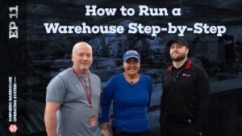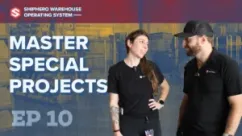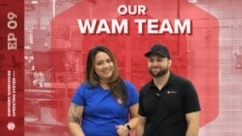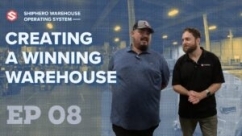Video Transcript
Danno Starc (00:06): Hello everyone, and welcome to another episode of ShipHero Feature Walkthroughs. I'm joined today by Yosef, our ShipHero BP of Product. So how are you today, Yosef? Yonef Haas (00:18): Good, Danno, how are you doing? Danno Starc (00:19): I'm good. So today Yosef will help us take a deeper look into a ShipHero feature. Is that so? Yonef Haas (00:27): Yeah, yeah. We're going to talk a little bit about how to optimize multi-item batches. Danno Starc (00:33): Awesome. Yonef Haas (00:33): Okay. So multi-item batches, as anybody who's used ShipHero, has seen some of our videos knows, is a way to pick multiple orders at a time using the mobile app where you can walk around your warehouse and the system will tell you where to go, which items to pick, and allow you to efficiently pick those items. So what I want to talk about today are some strategies to optimize the batches that are generated in ShipHero so that you're picking those batches in the most efficient way possible. So we're going to look at a few different types of strategies. Some of them will be rules or things you can set up in ShipHero, and then some settings that you can change to allow the system to be smarter about the batches it's suggesting for you. (01:18): We're going to start with custom statuses. Now, custom statuses can be used to segment the orders that you're picking. Some examples and some use cases we see are segmenting by item size, order size, order mix. And by order mix I mean the types of items that are in an order by the picker and by priority. So let's take a look at some of those a little more closely. (01:40): So item size, if you have items that are large, maybe they can't fit on your regular carts or they're difficult to pick with other items, it's good to separate those into their own statuses so they can be picked separately. So for example, let's say you have orders that need a forklift or a different type of cart to pick. Maybe you're selling refrigerators and also refrigerator magnets. Clearly you don't want the same person to be picking the magnets and the refrigerator. So based on the size of one of the items in the order, you can separate those into their own status. Similar with order size; an order with one or two or three items is going to be picked differently than an order with 50 or 100 items. (02:22): Order mix, again, the types of items they may be picked together. Maybe you have orders that have hazardous or high value items and you want to make sure they're picked separately than your other orders. Another strategy is to do it by picker. So if you want to assign certain orders to an individual picker, you can do that using customer status as well. (02:41): And then priority. So priority is anything that you determine needs orders to go out sooner. Maybe that's based on the type of customer or what the customer paid or just when the order came in or maybe what shipping method. It's a way to keep those orders in the same batch so they're picked together. (02:58): Now statuses can be set using automation rules. So you'll create your trigger for that rule and the action would be to set it to a customer status. And then pickers will only see orders in that custom status. So for example, if I have my hazardous material status, picker would have to be assigned to that status to pick those orders. And what this allows you to do is make sure that the orders that you're picking go together. So again, taking the example of the large items and the small items, it's very inefficient to have the same person picking orders that have very small items and very large items at the same time. So by separating them, we're able to make that picking more efficient. (03:37): Another thing can you use is order tags. Very similar to order statuses, so you can see the examples here are the same as we just talked about with order statuses. Similarly, they can be used using automation rules and pickers will only see the orders that the tags they're assigned to. (03:53): Now tags can be used in conjunction with order statuses. So for example, if you have a picker assigned to a status and a tag, they'll only see orders that are in that status and contain that tag. So it's a way to further refine or further segment the orders that the picker is picking. And it has the same benefit as we talked about with statuses; gives you the ability to make sure that the orders you're picking go together and are the most efficient for those orders being picked. (04:24): Now the next thing we'll talk about is a priority flag. A priority flag is set on the order and allows you to determine which orders get picked first. So if you have high priority orders, high value orders, orders that need to go out sooner, you can check off that flag on an order. It can also be set using automation rules. And this tells the system that when we're looking for orders to put into the batch, do these first. (04:51): Now let's talk about one of the settings we have to determine how your batches are optimized. So there's a setting that allows you to choose what type of optimization we use when creating those batches. There's three different settings: one of them is minimizing the walk to the same location, one is for location prefix, and one is by required ship date and priority. So minimizing walk for same location, that's going to look for items that are in the same location as you're going through. So for example, if in the batch you're going to location A1, we're going to look for other orders that are also in A1. And that's good for smaller warehouses where there's mixed bins and there's a greater chance of there being multiple products in the same bin. (05:34): So the next setting is minimizing it by location prefix. Now the prefix, when we built it, we're looking at the first three letters of the location; that's something we may expand or give you more flexibility in terms of what that prefix is. But right now it's looking at the first three letters, looking for orders that are in a location that share prefix for a location you're at anyway. So if you're in a location and a location near it that has the same prefix has orders, we'll include those in the batch because you're at that location anyway. And that's more efficient for larger warehouses that have many SKUs. So they have a big warehouse, a lot of different products, each product is in its own location. Instead of looking at just that one location as the previous setting is, we're going to try to find orders that are near the location you're already at. (06:21): Next one is required ship data and priority. But that's really not looking at the locations, but if you want to make sure that the batches are optimized or the batches are built based upon the orders that have to go out first, that's the setting you want. So there's always going to be that trade-off between, do I want to pick the orders that need to go out first or do I want to pick the orders that are most efficient to pick? You can't really do both. You have to decide which one you're starting with. Now, within the setting of required ship date and priority, we're still going to try to optimize the walk, but if we're leaning more towards what needs to go out first, obviously you're going to give something up on the walk. So that is a balance. As I said, you could change it at any time. So some people may change that in the morning to do a minimized walk, and the afternoon maybe they really need to get some orders out so they change it to required ship data and priority. (07:14): The next thing is to use bulk ship and single item batch. And the reason behind that is you want to reduce the number of single item orders is being picked in a multi-item batch. The more items we have to look at as a whole, the more efficient we can be. So if there's orders with more items, we can then try to include other orders that share those items and we can be more efficient. If we're picking a lot of single item orders, we really have to go where those items are. We can't look for other items that are shared because they're single item orders. (07:44): So bulk ship and single item batch are really going to allow you to move those items out and not pick them in the multi-item batch. So a strategy that a lot of customers use is do those first. So do the bulk ship, create those batches, do the single item batches, and then configure your multi-item batches. There is a setting to exclude orders containing one line item from multi-item batch picking, and that'll just remove all those completely. That is a little dangerous because if you don't do bulk ship and single item batch, you're not on top of it, those single item orders are not going to be picked. So if you do turn that on, just be aware that you do need to make sure you're on top of your bulk ship and single item batch so you don't leave any orders behind. (08:27): Next thing to take into consideration is location naming, what you actually name your locations. ShipHero allows to be very flexible in how you name it. There's no specific layout or a specific guide you have to use, but when you do decide on how you want to structure your location, just pay attention to a few things. (08:45): So first thing you want to do is make sure that they sort alphanumerically. What I mean is when we send the picker around the warehouse, after we figure out where to go, we want to send them in the order that locations are in. So we're going to sort those locations alphanumerically. One very important thing to pay attention to is that all your locations should have the same number of digits. So alphanumerically, A11 actually comes before A2. So if you do have two digits or three digits, just make sure that you have zeros padded. So instead of A11 and A2, do A02, and that comes before A11. And just make sure that's true throughout the entire location name. Always make sure that it's in the same number of your digits and use zeros to pad if they're not. (09:36): So the next thing you want to look at is location prefix, make sure that it's meaningful. And what I mean by that is location prefix should actually mean that two locations with the same prefix are somewhat near each other. So if you have the same location prefix, so the same first three digits of your location could be shared across the warehouse, that's not going to be very helpful. So right now with the way we set it up, we're looking at the first three letters. Just make sure that the first three letters, if they're the same, means they're somewhere near each other. Maybe that's the same aisle, maybe they don't have to be right next to each other, but at least they're somewhat close so if you're grouping by that prefix, it's giving you a more efficient batch. (10:16): Next thing you do is zigzag for narrow aisles. What we mean by that is if you do have aisles that are narrow, and your definition of narrow may vary, but thinking about it, if a picker can easily go from one side to the other side without taking too many steps, you want to make sure they're picking from both sides. So don't make one side of the aisle Aisle A, and the other side Aisle B, if they can easily pick from both sides. If you have very wide aisles, you want them to pick them separately; you don't want them going back and forth and zigzagging if going across takes a lot of steps. One of the ways we see is more like a street address where one side is odd, one side is even, but they're all the same name. And this way we're able to send the picker from one side to the other and it doesn't take them too many steps. (11:03): Now if you do have very long aisles, a good strategy might be to use the snake pattern. What that is when you get to the end of one aisle, you start the next aisle at the end. So in other words, you get to the end, let's say it's position 200, immediately to the left is location one of the next aisle. Now the one downside to that is it's a little harder for people to know where things are. They have to know what the aisle is, and if the aisle is starting from one side or the other. You can get around that by just having signs at the end of each aisle. So you can have a sign, "A1 is over here and B200 is over here." Just make it easy for somebody to glance and know what they're looking at. (11:43): Now, some of the things that are next, things that we're working on that will further optimize batches. So one thing we're doing is more batch optimization. So we're trying to fine tune the algorithm to give you more options on prefixes and grouping and how we determine what should be picked in a batch. So we have a data team now, a data science team. They're hard at work looking at the data we have and really trying to work on how we can optimize the batches better so when we create a batch, it really is the most efficient batch possible. (12:12): So another thing we're looking at is warehouse mapping, and that's basically allowing us to know what the warehouse looks like, what dimensions are, what locations are close to one another. So for example, we talked about before with the snake pattern, a way for us to know that A200 is really very close to B1, and B200 is very far from A200. So we can do that in many different ways; there's very simple things like just spreadsheets with giving us some information about the warehouse, something really advanced like 3D mapping. We're exploring different options, trying to figure out what's going to be the most efficient and not require some investment in a warehouse 3D mapping technology. But we're looking at some options and how we can use that to further optimize the batches. (12:59): Another thing we're exploring is pre-planning batches. What that would do is allow us to create the batches before the picker goes to request it. And that'll really accomplish a couple of things. First of all, it would allow us to make that process of getting a batch much quicker. So if the batch is pre-generated and pre-planned, as soon as the picker hits the button, they'll get the batch. There's no waiting to figure it out then. And we can also spend more time in figuring out what the batch should be. So if the picker hits a button and we have to calculate it in real time, if we spent a minute on it, yeah, we may have a better batch, but the picker's waiting for a minute; we don't want to do that. (13:32): So we have to balance how much time should we spend on figuring out the most optimized batch versus how long we want the picker to wait. If we pre-plan them and pre-generate them, we could spend a minute or two figuring out the most optimized batch and that's not a problem because there's nobody waiting for it. That's something we're looking at. We're doing some tests with it and seeing where we can go with that. (13:54): Another thing is zone picking. So zone picking will allow you to separate your warehouse into zones and have each zone picked separately. So if you have, like we talked about before, maybe large items or hazardous items, you don't have to include them in the same batch, but they can be picked by one person and then that tote brought to another zone to pick the rest of the items. So that will allow us to really optimize not only what gets picked when and where, but allows you not to have to worry as much about things like statuses and separating orders and worrying about orders with mixed items. So I have hazardous and non-hazardous, now I have to pick them together in the same batch right now. Over the zone picking, you'll be able to pick them separately. So one person picks the hazardous or picks the high value, and then that tote goes over to the other zone to pick the rest of the items. And that will allow you to generate more efficient batches and be more efficient with your pickers. (14:48): So hopefully that gave you some ideas on the things you could do in ShipHero to have more optimized multi-item batches and some of the ways in which ShipHero uses that to create more optimized batches. And of course, some of the things we're working on down the line in the next few months to give you even more efficient batches. Danno Starc (15:07): Awesome, Yosef. That was super interesting and really insightful. And if you'd like to check out other feature walkthroughs, click on the top right corner right now. And if you're ready to unlock your e-commerce fulfillment superpowers, visit ShipHero.com to schedule a call with us. Thank you for watching and have a great day.






